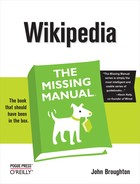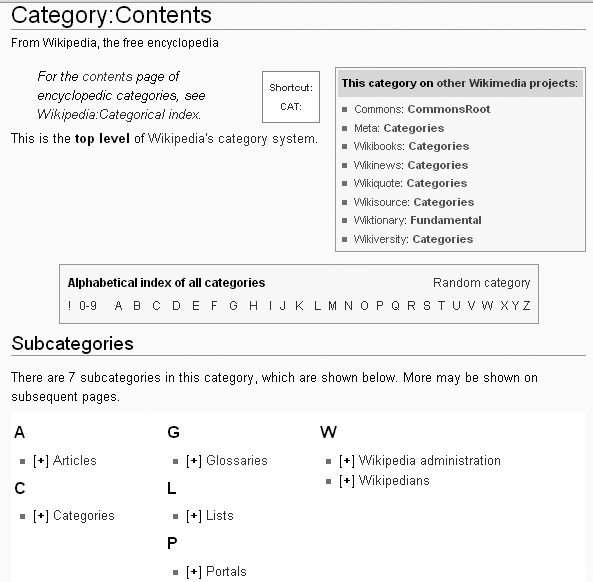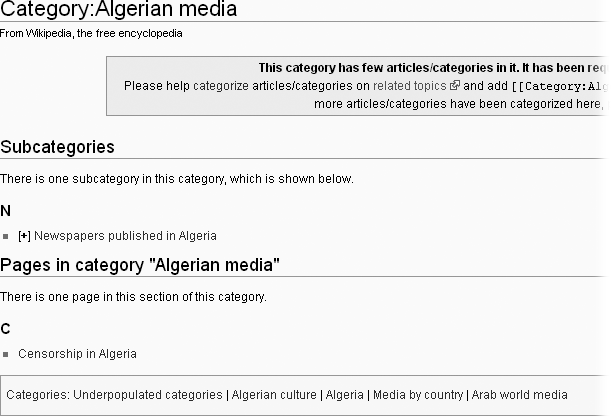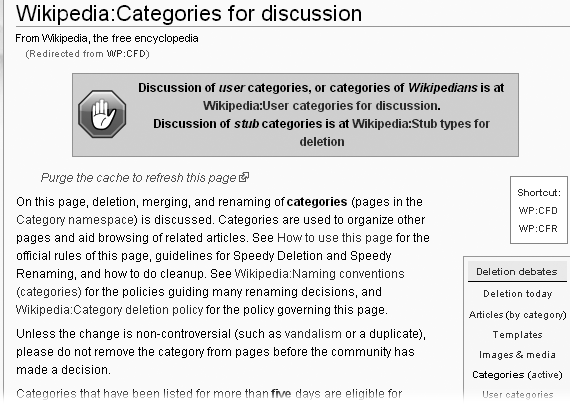As you work on adding good categories to articles, you’ll encounter category pages like the one in Figure 17-1, and as a reader, you’ll find them useful for getting to articles you’re interested in. But there’s more to category pages. They’re created and managed by editors, and, like all other pages at Wikipedia, there are times when you, as an editor, can edit them to improve them. This section explains what you need to know.
Every category page should have at least one parent—a higher-level category. (The exception, of course, is the category page at the very top of the hierarchy.) Or, to put it differently, every category page but the very highest (shown in Figure 17-5) should be within a subcategory of at least one higher-level category.
Figure 17-5. The highest category in Wikipedia—the only category that doesn’t belong to a higher category—is Category:Contents. It has seven subcategories and (not shown) one page that belongs to the category but isn’t in a subcategory, the page Wikipedia:Contents.
Figure 17-6 shows a category page that itself is assigned five categories.
Figure 17-6. The category page Algerian media has five parent categories—one is a cleanup category; the other four are higher level topical categories. Put differently, Algerian media is a subcategory of five categories, four of them topical and one a cleanup category.
Did you spot the error with the five parent categories in Figure 17-6? The problem is that Algerian culture, if you check, also has the parent category Algeria. A category page shouldn’t have two parents where one parent (Algerian culture, in this case) is itself a subcategory of the other parent (Algeria, in this case). One parent category (Algerian culture) is enough, since someone looking at the higher level category (Algeria) can always find the page by just drilling down.
Fixing this categorization error is simple: Open the page Category:Algerian culture for editing (Figure 17-7), find the line with [[Category:Algeria|Media]], and delete that. Then, following the standard procedure, add an edit summary, do a preview (categories show up at the very bottom of the page), and save the change.
Figure 17-7. On the category page Algerian culture, the line with [[Category:Algeria|Media]] needs to be deleted, since [[Category:Algerian culture]] already leads to that. While you’re looking at the wikitext, note that three of the four categories listed have a sort order, which affects where this category page is displayed on the higher level category page (under “A” or “M”). Finally, notice the two interlanguage links—German and French—which create links in the left margin to similar category pages at the German and French versions of Wikipedia.
Note
You can find category pages without parents (category pages not themselves in a subcategory) by looking at the page Special:Uncategorizedcategories. This page is a specialized report that’s not constantly updated, so if you’re not looking at a fresh report, you’ll probably find that a lot of the listed pages have either been fixed or proposed for deletion. If you find categorization interesting, you may want to help out here: Every category page but one (Category:Contents) should have a parent category.
Changing a category assigned to an article or a category assigned to a category page is easy—just a quick edit. By contrast, if you want to rename a category page, you need to go through a longer process; you can’t just click the “move” tab, because there is no move tab.
Renaming, merging, and deletion of pages in the Category namespace is discussed at Wikipedia:Categories for discussion (shortcut: WP:CFD). See Figure 17-8.
Figure 17-8. The page Wikipedia:Categories for discussion is for discussion of renaming, merging, or deleting of all types of categories except for two, discussed elsewhere: user categories (as in Category:Wikipedians who dislike excessive categorization) and stubs (categories for very short articles). There’s a separate page for discussion of user categories probably because they can be particularly controversial, or trivial. The separate page for discussion of stub categories is because this is a very specialized area.
If you think this type of action is needed, follow the instructions on the WP:CFD page. Note that there are sections for non-controversial actions: “speedy renaming” (after a wait of 48 hours) and “speedy deletion” (for example, because a category is what Wikipedia calls “patent nonsense,” defined as something “unsalvageably incoherent”).
If the category doesn’t exist, you can create one. Whether you should create a new category, however, is another matter. While Wikipedia clearly still needs a lot more articles, it’s not clear that it needs a lot more categories for those articles. So, here are some questions to consider before you create a new page:
Will the new category have more than a few pages on it? The more pages you can put that fit the category, the more likely the category will survive. A category with just one article belonging to it is likely to have a short life.
Is the category being added to pages that already have adequate categories assigned to them? As the guideline Wikipedia:Overcategorization (shortcut: WP:OC) says, “not every verifiable fact (or the intersection of two or more such facts) in an article requires an associated category. For lengthy articles, this could potentially result in hundreds of categories, most of which aren’t particularly relevant.” (The essay “Do not write articles using categories”—shortcut WP:DNWAUC—is also informative on this mater.)
Is the category name neutral and factual? A category like Shiftless no-good politicians who should be recalled from office is hopelessly non-neutral (see WP:NPOV), not to mention unverifiable (see WP:V).
If a category seems obvious, did you thoroughly look for it under a different name? Particularly when you’re adding a category to a new or stubby article, don’t just assume that if Category:People from New Zealand doesn’t exist, and if it fits the article, you should create it. (See Finding the Right Category for more detail on finding good categories for articles.)
If you decide to create a new category, you do that by creating a category page, exactly as you would any other page. Just type the name (for example, Category:Some new article category that Wikipedia needs) into the search box, and click Go. When the software tells you no such page exists, click the “Create the page” link, type some introductory information about the category, and save the page.
Note
Alternatively, you can first add a not-yet-created category to an article, which creates a red link. When you click the red link, you’ll see the “Create this page” option. Click it, and then follow the rest of the procedure in the prior paragraph.
There’s one clear exception to the general rule that you should always be hesitant to create a new category: when a lot of articles (say, over a hundred) are in a non-cleanup category that has no subcategories, or are in a category when no applicable subcategories for them exist. In such a case, creating additional subcategories, and moving articles out of the category and into a subcategory by editing article pages, is a good thing to do.



![On the category page Algerian culture, the line with [[Category:Algeria|Media]] needs to be deleted, since [[Category:Algerian culture]] already leads to that. While you’re looking at the wikitext, note that three of the four categories listed have a sort order, which affects where this category page is displayed on the higher level category page (under “A” or “M”). Finally, notice the two interlanguage links—German and French—which create links in the left margin to similar category pages at the German and French versions of Wikipedia.](http://imgdetail.ebookreading.net/design/5/9780596515164/9780596515164__wikipedia-the-missing__9780596515164__httpatomoreillycomsourceoreillyimages20139.png)
